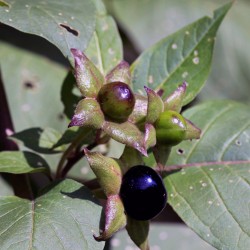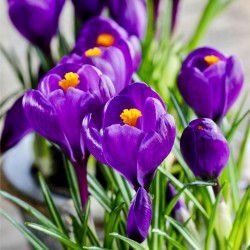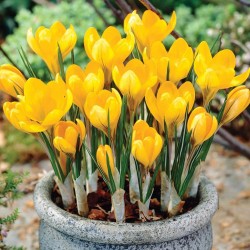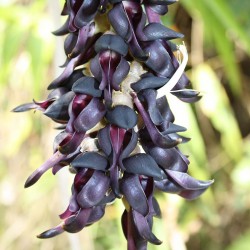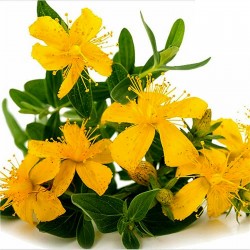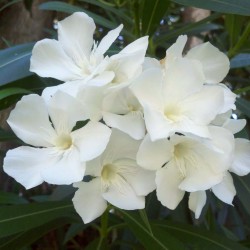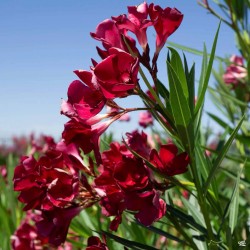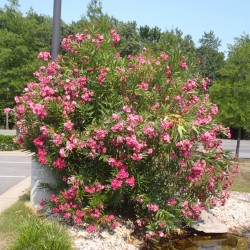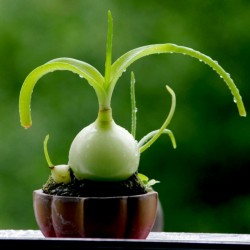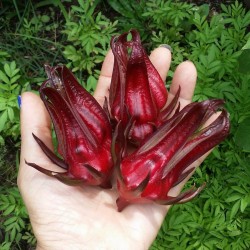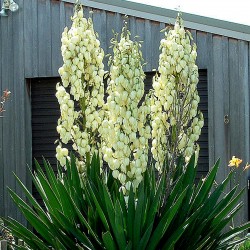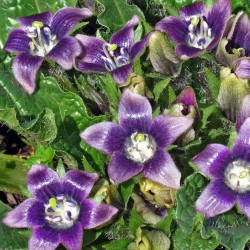
Mandrake seeds (Mandragora...
Price
€15.00
SKU: MHS 16
Seeds Gallery Com,
5/
5
<meta http-equiv="Content-Type" content="text/html; charset=UTF-8" />
<h2><strong>Mandrake seeds (Mandragora officinarum)</strong></h2>
<h2><span style="color: #ff0000;"><strong>Price for Package of 5 seeds.</strong></span></h2>
<p><i><b>Mandragora officinarum</b></i><span> </span>is the<span> </span>type species<span> </span>of the plant<span> </span>genus<span> </span><i>Mandragora</i>. It is often known as<span> </span><b>mandrake</b>, although this name is also used for other plants. As of 2015, sources differed significantly in the species they use for<span> </span><i>Mandragora</i><span> </span>plants native to the<span> </span>Mediterranean region. The main species found around the Mediterranean is called<span> </span><i>Mandragora autumnalis</i>, the autumn mandrake. In a broader circumscription, all the plants native to the regions around the Mediterranean Sea are placed in<span> </span><i>M. officinarum</i>, which thus includes<span> </span><i>M. autumnalis</i>. The names<span> </span><b>autumn mandrake</b><span> </span>and<span> </span><b>Mediterranean mandrake</b><span> </span>are then used.<sup id="cite_ref-GRIN_2-0" class="reference">[2]</sup><span> </span>Whatever the circumscription,<span> </span><i>Mandragora officinarum</i><span> </span>is a perennial herbaceous plant with ovate leaves arranged in a rosette, a thick upright root, often branched, and bell-shaped flowers followed by yellow or orange<span> </span>berries.</p>
<p>Because mandrakes contain<span> </span>deliriant<span> </span>hallucinogenic<span> </span>tropane alkaloids<span> </span>and the shape of their roots often<span> </span>resembles human figures, they have been associated with a variety of superstitious practices throughout history. They have long been used in<span> </span>magic<span> </span>rituals, today also in<span> </span>contemporary pagan<span> </span>practices such as<span> </span>Wicca<span> </span>and<span> </span>Heathenry.<sup id="cite_ref-Moore_3-0" class="reference">[3]</sup><span> </span>However, the so-called "mandrakes" used in this way are not always species of<span> </span><i>Mandragora</i><span> </span>let alone<span> </span><i>Mandragora officinarum</i>; for example,<span> </span><i>Bryonia alba</i>, the English mandrake, is explicitly mentioned in some sources.</p>
<p>As of 2015,<span> </span><i>Mandragora officinarum</i><span> </span>has three or four different<span> </span>circumscriptions<span> </span>(see<span> </span>Taxonomy<span> </span>below). The description below applies to a broad circumscription, used in a 1998 revision of the genus, in which the name is used for all the plants native to<span> </span>Mediterranean region.<sup id="cite_ref-Ungr98_1-1" class="reference">[1]</sup><span> </span>Thus defined,<span> </span><i>Mandragora officinarum</i><span> </span>is a very variable<span> </span>perennial<span> </span>herbaceous plant<span> </span>with a long thick root, often branched. It has almost no stem, the leaves being borne in a basal rosette. The leaves are very variable in size and shape, with a maximum length of 45 cm (18 in). They are usually either elliptical in shape or wider towards the end (obovate), with varying degrees of hairiness.<sup id="cite_ref-Ungr98_1-2" class="reference">[1]</sup></p>
<p>The flowers appear from autumn to spring (September to April). They are borne in the axils of the leaves. The flower stalks (pedicels) are also very variable in length, up to 45 cm (18 in) long. The five<span> </span>sepals<span> </span>are 6–28 mm (0.2–1.1 in) long, fused together at the base and then forming free lobes to about a half to two-thirds of their total length. The five<span> </span>petals<span> </span>are greenish white to pale blue or violet in colour, 12–65 mm (0.5–2.6 in) long, and, like the sepals, joined together at the base with free lobes at the end. The lobes are between half as long as the petals to almost as long. The five<span> </span>stamens<span> </span>are joined to the bases of the petals and vary in length from 7 to 15 mm (0.3 to 0.6 in). The anthers of the stamens are usually yellow or brown, but are sometimes pale blue.<sup id="cite_ref-Ungr98_1-3" class="reference">[1]</sup></p>
<p>The fruit which forms in late autumn to early summer (November to June) is a<span> </span>berry, shaped like a globe or an ellipsoid (i.e. longer than wide), with a very variable diameter of 5–40 mm (0.2–1.6 in). When ripe, the fruit is glossy, and yellow to orange – somewhat resembling a small tomato. It contains yellow to light brown seeds, 2.5–6 mm (0.10–0.24 in) long.<sup id="cite_ref-Ungr98_1-4" class="reference">[1]</sup></p>
<p>Earlier, a different circumscription was used, in which<span> </span><i>Mandragora officinarum</i><span> </span>referred only to plants found in northern Italy and part of the coast of former<span> </span>Yugoslavia, most Mediterranean mandrakes being placed in<span> </span><i>Mandragora autumnalis</i>.<sup id="cite_ref-FE_4-0" class="reference">[4]</sup><sup id="cite_ref-JackBerr79_5-0" class="reference">[5]</sup><span> </span>The description above would then apply to both species combined, with<span> </span><i>M. officinarum</i><span> </span>having greenish-white rather than violet petals, up to 25 mm (1 in) long rather than usually 30–40 mm (1.2–1.6 in) or longer, and a berry that is globose rather than ellipsoid.<sup id="cite_ref-FE_4-1" class="reference">[4]</sup><span> </span>More recently, plants native to the<span> </span>Levant<span> </span>have been separated out as<span> </span><i>Mandragora autumnalis</i>, leaving those found in the rest of the Mediterranean area as<span> </span><i>M. officinarum</i>. One difference then is that the size of the seeds of<span> </span><i>M. officinarum</i><span> </span>is less than half the size of those of<span> </span><i>M. autumnalis</i>.</p>
<h2><span class="mw-headline" id="Medicinal_use">Medicinal use</span></h2>
<div role="note" class="hatnote navigation-not-searchable">Main article:<span> </span>Mandrake</div>
<div class="thumb tright">
<div class="thumbinner"><img alt="Mandrake seeds (Mandragora officinarum)" src="https://upload.wikimedia.org/wikipedia/commons/thumb/6/68/Mandragoras_454_Dodoens_1583.png/170px-Mandragoras_454_Dodoens_1583.png" decoding="async" width="170" height="258" class="thumbimage" srcset="//upload.wikimedia.org/wikipedia/commons/thumb/6/68/Mandragoras_454_Dodoens_1583.png/255px-Mandragoras_454_Dodoens_1583.png 1.5x, //upload.wikimedia.org/wikipedia/commons/thumb/6/68/Mandragoras_454_Dodoens_1583.png/340px-Mandragoras_454_Dodoens_1583.png 2x" data-file-width="2620" data-file-height="3970" title="Mandrake seeds (Mandragora officinarum)" />
<div class="thumbcaption">
<div class="magnify"></div>
The so-called "female" and "male" mandrakes, from a 1583 illustration</div>
</div>
</div>
<p>Mandrake has a long history of medicinal use, although<span> </span>superstition<span> </span>has played a large part in the uses to which it has been applied.<sup id="cite_ref-w_lee_2_14-0" class="reference">[14]</sup><span> </span>WebMD, which categorises the herb European Mandrake derived from Mandragora officinarum under the heading "Vitamins & Supplements", declares that it is UNSAFE for anyone to use European mandrake for medicinal purposes.<sup id="cite_ref-WebMD_european-mandrake_15-0" class="reference">[15]</sup><span> </span>In the UK, The Prescription Only Medicines (Human Use) Order 1997, in its Schedule 1,<sup id="cite_ref-POMOrder1997_16-0" class="reference">[16]</sup><span> </span>identifies "<i>Mandragora autumnalis</i>" as a substance which, if included in medicinal products, makes those products prescription only medicines, and therefore only prescribable by those categories of appropriate practitioners specified in Regulation 214 of The Human Medicines Regulations 2012.<sup id="cite_ref-HumMedReg2012_17-0" class="reference">[17]</sup><span> </span>Medical herbalists are not recognised as "appropriate practitioners" under this legislation.<span> </span><i>Mandragora autumnalis</i><span> </span>Bertol.<sup id="cite_ref-PlantsWorldOnline_MAutumnalis_18-0" class="reference">[18]</sup><span> </span>is currently an accepted species distinguishable from<span> </span><i>Mandragora officinarum</i><span> </span>L.,<sup id="cite_ref-PlantsWorldOnline_MOfficinarum_19-0" class="reference">[19]</sup>, so it follows that mandrake preparations and products derived from<span> </span><i>Mandragora officinarum</i><span> </span>L. may not actually be covered by this UK legislation. However, the European Medicines Agency, which oversees the registration of herbal medicinal products in the European Union, does not recognise mandrake, and indeed any<span> </span><i>Mandragora</i><span> </span>species, as an approved herbal medicinal product, substance, or preparation under the European Directive on Traditional Herbal Medicinal Products.<sup id="cite_ref-THMPD2004_24_EC_20-0" class="reference">[20]</sup></p>
<p>The root is<span> </span>hallucinogenic<span> </span>and<span> </span>narcotic. In sufficient quantities, it induces a state of<span> </span>unconsciousness<span> </span>and was used as an<span> </span>anaesthetic<span> </span>for<span> </span>surgery<span> </span>in ancient times.<sup id="cite_ref-Grieve_21-0" class="reference">[21]</sup><span> </span>In the past, juice from the finely grated root was applied externally to relieve<span> </span>rheumatic<span> </span>pains.<sup id="cite_ref-Grieve_21-1" class="reference">[21]</sup><span> </span>It was also used internally to treat<span> </span>melancholy,<span> </span>convulsions, and<span> </span>mania.<sup id="cite_ref-Grieve_21-2" class="reference">[21]</sup><span> </span>When taken internally in large doses, however, it is said to excite<span> </span>delirium<span> </span>and madness.<sup id="cite_ref-Grieve_21-3" class="reference">[21]</sup></p>
<p>In the past, mandrake was often made into<span> </span>amulets<span> </span>which were believed to bring good fortune and cure sterility. In one superstition, people who pull up this root will be condemned to<span> </span>hell, and the mandrake root would scream as it was pulled from the ground, killing anyone who heard it.<sup id="cite_ref-Moore_3-1" class="reference">[3]</sup><span> </span>Therefore, in the past, people have tied the roots to the bodies of animals and then used these animals to pull the roots from the soil.</p>
MHS 16 (5 S)





